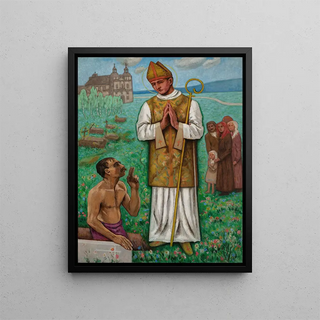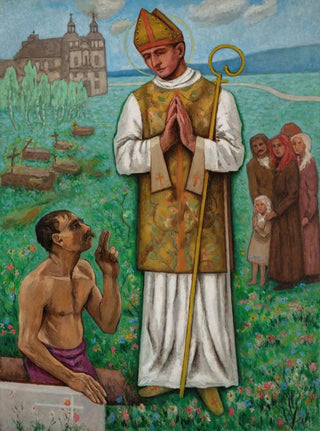Art print | The Renaissance of Piotrowin - Tadeusz Makowski


View from behind

Frame (optional)
In the vibrant universe of art, certain works stand out for their ability to capture the essence of humanity while evoking deep emotions. "The Renaissance of Piotrowin" by Tadeusz Makowski is one of these masterful pieces that transcends time and space. This artwork, rich in colors and symbolism, immerses us in a world where life and death coexist, where nature and man intertwine in an eternal dance. By contemplating this art print, the viewer is immediately transported to a universe where every detail tells a story, where each shade of color evokes an emotion. Makowski's work is a true sensory journey, an invitation to explore the depths of the human soul and the mysteries of existence.
Style and uniqueness of the work
Tadeusz Makowski's style is characterized by a unique approach that combines figurative art with abstraction. In "The Renaissance of Piotrowin," the artist skillfully plays with shapes and colors, creating an atmosphere that is both dreamlike and tangible. The vibrant hues and striking contrasts bring to life a landscape where nature seems to breathe, where the characters, although stylized, express a palpable emotional intensity. Makowski uses flowing lines and dynamic compositions to guide the viewer's gaze across the canvas, gradually revealing the layers of meaning hidden behind each element. This work is a celebration of life, a tribute to the ephemeral beauty that surrounds us, inviting everyone to reflect on their own existence and their relationship with the world.
The artist and his influence
Tadeusz Makowski, an emblematic figure of 20th-century Polish art, managed to mark his era with a unique artistic vision. Born in a tumultuous context, he transformed his personal experiences into a rich and complex body of work. Influenced by surrealism and expressionism, Makowski developed a style that is his own, blending elements of European tradition with more contemporary inspirations. His work has had a significant impact on the art scene, inspiring many artists to explore new avenues of expression.

Matte finish

View from behind

Frame (optional)
In the vibrant universe of art, certain works stand out for their ability to capture the essence of humanity while evoking deep emotions. "The Renaissance of Piotrowin" by Tadeusz Makowski is one of these masterful pieces that transcends time and space. This artwork, rich in colors and symbolism, immerses us in a world where life and death coexist, where nature and man intertwine in an eternal dance. By contemplating this art print, the viewer is immediately transported to a universe where every detail tells a story, where each shade of color evokes an emotion. Makowski's work is a true sensory journey, an invitation to explore the depths of the human soul and the mysteries of existence.
Style and uniqueness of the work
Tadeusz Makowski's style is characterized by a unique approach that combines figurative art with abstraction. In "The Renaissance of Piotrowin," the artist skillfully plays with shapes and colors, creating an atmosphere that is both dreamlike and tangible. The vibrant hues and striking contrasts bring to life a landscape where nature seems to breathe, where the characters, although stylized, express a palpable emotional intensity. Makowski uses flowing lines and dynamic compositions to guide the viewer's gaze across the canvas, gradually revealing the layers of meaning hidden behind each element. This work is a celebration of life, a tribute to the ephemeral beauty that surrounds us, inviting everyone to reflect on their own existence and their relationship with the world.
The artist and his influence
Tadeusz Makowski, an emblematic figure of 20th-century Polish art, managed to mark his era with a unique artistic vision. Born in a tumultuous context, he transformed his personal experiences into a rich and complex body of work. Influenced by surrealism and expressionism, Makowski developed a style that is his own, blending elements of European tradition with more contemporary inspirations. His work has had a significant impact on the art scene, inspiring many artists to explore new avenues of expression.






